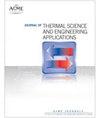Thermodynamic and Thermo - economic Analysis of a Solar Integrated Double Turbine Kalina Cycle for varying Solar Flux Conditions
IF 1.4
4区 工程技术
Q3 ENGINEERING, MECHANICAL
引用次数: 0
Abstract
Kalina cycle is established as a reliable low-grade energy cycle working on solar, geothermal and other waste heat recovery sources. This work aims to develop a novel methodology for optimizing a Kalina cycle according to the solar irradiation. A comprehensive analysis of performance is conducted by varying the parameters of the Kalina system, modeled with high and low pressure turbines. The present work implements and analyses the performance of a multi turbine Kalina cycle with cylindrical parabolic collectors for energy input at different time, on a particular day, for a location. The proposed cycle is modeled to simulate the working. The dependency of parameters - separator pressure, concentration of ammonia in boiler, intermediate separator temperature and vapor fraction at condenser side turbine exit - on the system performance is investigated. Optimization is conducted using genetic algorithm with net power as objective function for different solar irradiations. The optimized power values are 282.62, 246.75, 222.31 and 180.0 kW for solar influxes 507.7, 461.8, 413.9 and 321.0 W/m 2 respectively. The results show that the proposed model can be adopted for better performance. A thermo – economic analysis of an optimized output is conducted to conclude on capital investment and operation cost for sustainable power production. The analysis yields highest cost rate of exergy destruction of 58936.41$/yr for the boiler. The investment cost the turbines together is 89% of the total capital investment and hence thermo - economic factor is highest for these components.不同太阳通量条件下太阳能集成双涡轮Kalina循环的热力学和热经济分析
Kalina循环是一种可靠的低品位能源循环,利用太阳能、地热和其他余热回收资源。本工作旨在根据太阳辐照发展一种优化Kalina循环的新方法。通过改变Kalina系统的参数,以高压和低压涡轮机为模型,对性能进行了全面的分析。本工作实现并分析了多涡轮Kalina循环的性能与圆柱形抛物面收集器的能量输入在不同的时间,在一个特定的一天,为一个位置。对所提出的周期进行建模以模拟其工作。研究了分离器压力、锅炉氨浓度、中间分离器温度和冷凝器侧汽轮机出口汽分等参数对系统性能的影响。采用遗传算法,以净功率为目标函数,针对不同的太阳辐照度进行优化。当太阳辐照量为507.7、461.8、413.9和321.0 W/m 2时,优化功率值分别为282.62、246.75、222.31和180.0 kW。结果表明,该模型具有较好的性能。对优化后的产量进行了热经济分析,得出了可持续发电的资金投入和运行成本。分析得出该锅炉的火用破坏成本最高,为58936.41美元/年。涡轮机的投资成本占总投资的89%,因此这些部件的热经济系数是最高的。
本文章由计算机程序翻译,如有差异,请以英文原文为准。
求助全文
约1分钟内获得全文
求助全文
来源期刊

Journal of Thermal Science and Engineering Applications
THERMODYNAMICSENGINEERING, MECHANICAL -ENGINEERING, MECHANICAL
CiteScore
3.60
自引率
9.50%
发文量
120
期刊介绍:
Applications in: Aerospace systems; Gas turbines; Biotechnology; Defense systems; Electronic and photonic equipment; Energy systems; Manufacturing; Refrigeration and air conditioning; Homeland security systems; Micro- and nanoscale devices; Petrochemical processing; Medical systems; Energy efficiency; Sustainability; Solar systems; Combustion systems
 求助内容:
求助内容: 应助结果提醒方式:
应助结果提醒方式:


